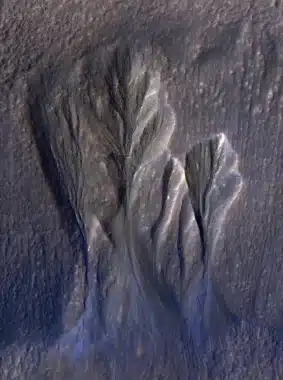NASA’s latest study proposes that subsurface meltwater beneath Mars’ icy layers could create environments capable of sustaining habitats. Researchers suggest that dusty ice formations allow sunlight to penetrate, enabling photosynthesis in shallow pockets of liquid water. These findings highlight Mars’ mid-latitudes as key areas where conditions might support biological processes, offering new potential targets in the search for life.
Life on Mars? NASA’s Latest Study Suggests Meltwater Beneath Ice Could Support Life

NASA researchers have proposed that beneath Mars’ frozen surface, meltwater pools could potentially support microbial life. Using computer models, scientists believe that sunlight filtering through dusty ice could create the right conditions for photosynthesis to occur in shallow subsurface water. This groundbreaking study opens up new possibilities in the search for extraterrestrial life and suggests that Mars’ icy regions could harbor conditions favorable to life.
Dust and Ice: Key Ingredients for Potential Life on Mars
The NASA study, led by Aditya Khuller of the Jet Propulsion Laboratory, sheds light on how dust within Martian ice could play a crucial role in creating subsurface meltwater. Just as on Earth, where dust particles within glacial ice absorb heat and create cryoconite holes, similar processes could be happening on Mars. These dusty ice layers, formed over millennia, could absorb sunlight and melt portions of the ice just below the surface, forming pockets of liquid water.
These findings suggest that in certain areas, dust particles might not only trap enough heat to create meltwater but also allow sufficient sunlight to penetrate the ice. “On Mars, the areas where photosynthesis could occur are more likely to be within dusty ice because the overlying dusty ice blocks harmful ultraviolet radiation,” explains Khuller, who emphasizes that this dusty ice could also protect potential life forms from Mars’ harsh environment.
Martian Ice: Shielding Life from Radiation while Enabling Photosynthesis
One of the key challenges to life on Mars is its exposure to harmful ultraviolet (UV) radiation. Without a magnetic field or ozone layer like Earth’s, the Martian surface is constantly bombarded by radiation that could easily destroy complex organic molecules. However, the dusty ice layers described in NASA’s study may offer a solution. These ice layers not only shield the surface from this radiation but also allow sunlight to pass through, creating the ideal environment for photosynthesis deep within the ice.
The study’s models suggest that photosynthetic life could exist as deep as 9 feet (3 meters) below the surface in regions with the right combination of dust concentration and sunlight. This radiative habitable zone could support microbial life, drawing a parallel to Earth’s glacial ecosystems, where life thrives in extreme conditions. Phil Christensen, co-author of the study, notes, “Dense snow and ice can melt from the inside out, letting in sunlight that warms it like a greenhouse, rather than melting from the top down.”
Potential Locations and Future Exploration
The study points to specific regions on Mars where these subsurface meltwater pockets might exist. According to the researchers, the mid-latitudes of Mars, between 30° and 60° latitude in both the northern and southern hemispheres, are the most likely candidates for harboring these photosynthetic zones. These areas have the right balance of temperature, dust levels, and sunlight, making them prime targets for future exploration.
The next phase of research will involve conducting lab simulations to recreate Mars’ icy conditions and further study how dusty ice interacts with sunlight. Khuller and his team are eager to explore these possibilities in greater detail, potentially guiding the development of future robotic missions to Mars. “We are not stating we have found life on Mars,” Khuller clarifies, “but instead we believe that dusty Martian ice exposures in the mid-latitudes represent the most accessible places to search for Martian life today.”
NASA’s ongoing exploration of Mars through missions like Perseverance and Mars Reconnaissance Orbiter will continue to refine our understanding of the planet’s ice-covered regions, potentially bringing us closer to discovering life beyond Earth.




